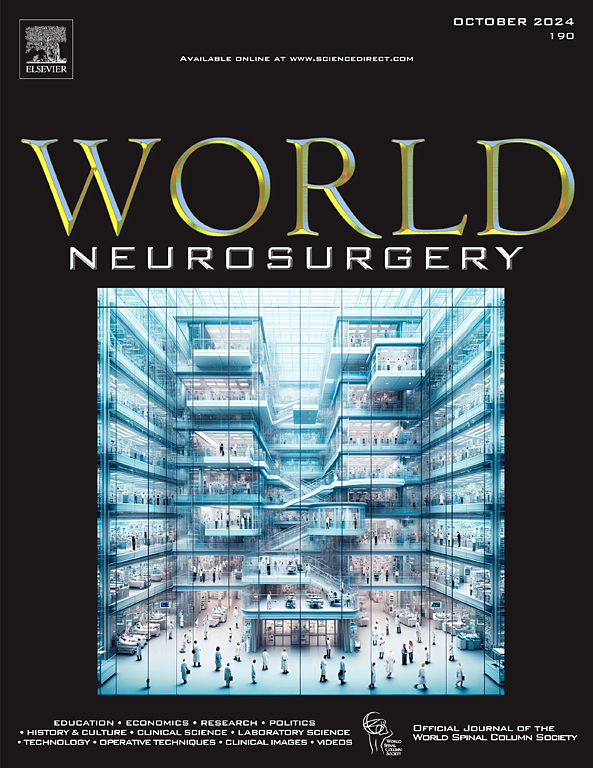Facet Distraction Distance Independently Predicts Cage Subsidence Following Anterior Cervical Discectomy and Fusion
IF 1.9
4区 医学
Q3 CLINICAL NEUROLOGY
引用次数: 0
Abstract
Objective
This study aimed to evaluate the relationship between facet distraction distance (FDD) and cage subsidence following anterior cervical discectomy and fusion (ACDF).
Methods
This retrospective study included patients who underwent ACDF for degenerative cervical disease at our institution between 2020 and 2023. Preoperative computed tomography scans were used to assess Hounsfield unit (HU) values, reflecting bone mineral density. Disc distraction distance (DDD) and FDD were measured using preoperative, immediate postoperative, and final follow-up radiographs. Multivariate logistic regression analysis was performed to identify independent risk factors for cage subsidence.
Results
A total of 80 patients were included in the study. Compared to the nonsubsidence group, the subsidence group demonstrated significantly greater DDD (P = 0.001) and FDD (P < 0.001), as well as lower HU values (P = 0.014). Multivariate logistic regression analysis identified lower HU values, greater DDD, and greater FDD as independent risk factors for subsidence. Receiver operating characteristic curve analysis revealed that the area under the curve for FDD was 0.762, with an optimal threshold of 0.66.
Conclusions
FDD is an independent predictor of cage subsidence following ACDF. To reduce the risk of subsidence, overdistraction of the interfacet space should be avoided.
小关节突撑开距离独立预测颈椎前路椎间盘切除术和融合后椎笼沉降。
目的:本研究旨在评估颈椎前路椎间盘切除术和融合(ACDF)后关节突牵张距离(FDD)和椎笼沉降之间的关系。方法:本回顾性研究纳入了2020年至2023年在我院因退行性宫颈疾病行ACDF的患者。术前计算机断层扫描(CT)用于评估Hounsfield单位(HU)值,反映骨矿物质密度(BMD)。通过术前、术后即刻和最后随访x线片测量椎间盘牵张距离(DDD)和FDD。通过多因素logistic回归分析,确定笼子下沉的独立危险因素。结果:共纳入80例患者。与非沉降组相比,沉降组DDD (p = 0.001)和FDD (p < 0.001)显著增加,HU值显著降低(p = 0.014)。多因素logistic回归分析发现,较低的HU值、较大的DDD和较大的FDD是沉降的独立危险因素。受试者工作特征(ROC)曲线分析显示,FDD的曲线下面积(AUC)为0.762,最佳阈值为0.66。结论:FDD是ACDF后笼子下沉的独立预测因子。为了减少下沉的风险,应避免过度分散界面空间。
本文章由计算机程序翻译,如有差异,请以英文原文为准。
求助全文
约1分钟内获得全文
求助全文
来源期刊

World neurosurgery
CLINICAL NEUROLOGY-SURGERY
CiteScore
3.90
自引率
15.00%
发文量
1765
审稿时长
47 days
期刊介绍:
World Neurosurgery has an open access mirror journal World Neurosurgery: X, sharing the same aims and scope, editorial team, submission system and rigorous peer review.
The journal''s mission is to:
-To provide a first-class international forum and a 2-way conduit for dialogue that is relevant to neurosurgeons and providers who care for neurosurgery patients. The categories of the exchanged information include clinical and basic science, as well as global information that provide social, political, educational, economic, cultural or societal insights and knowledge that are of significance and relevance to worldwide neurosurgery patient care.
-To act as a primary intellectual catalyst for the stimulation of creativity, the creation of new knowledge, and the enhancement of quality neurosurgical care worldwide.
-To provide a forum for communication that enriches the lives of all neurosurgeons and their colleagues; and, in so doing, enriches the lives of their patients.
Topics to be addressed in World Neurosurgery include: EDUCATION, ECONOMICS, RESEARCH, POLITICS, HISTORY, CULTURE, CLINICAL SCIENCE, LABORATORY SCIENCE, TECHNOLOGY, OPERATIVE TECHNIQUES, CLINICAL IMAGES, VIDEOS
 求助内容:
求助内容: 应助结果提醒方式:
应助结果提醒方式:


